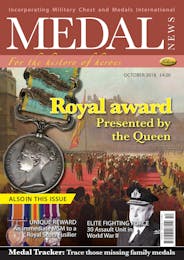The medal not the man? IN last month’s “News and Views” we announced that Worcestershire Medal Services had recently won the contract to produce the UK’s medals. What was particularly interesting about that story was the contract includes the production of historical medals too, not just the forthcoming issues. In other words, if granddad never applied for his medals after World War II and you decide you want to do so on his behalf, the medals you will receive (assuming old stocks have run dry) will be medals manufactured by Worcestershire. The chances are that you won’t know, that you simply won’t notice any difference; anyone who has ever held an Elizabeth Cross or a UK Diamond Jubilee medal will attest to the quality of Worcestershire Medal Services’ products, so that certainly won’t be an issue and it is possible that they may use the original dies anyway, so there will be no changes at all to the medals manufactured in the 2010s from those manufactured in the 1950s. However, it is worth noting that in numismatics, when there is a change of manufacturer for a coin or medal, or even just when a new die is used, there are sometimes tiny little changes that most of us don’t notice, but some collectors seek out with an almost religious zeal. It’s more common in the coin world to find people collecting varieties, and more common in that hobby to find those who actively look for them. I will never forget one of our COIN NEWS readers who happily wrote to me one day to tell me that he had counted through 250,000 10p pieces and had discovered that the Royal Mint was using two distinctly different dies for both obverse and reverse. Apparently Obverse A had x number of beads around Her Majesty’s effigy whilst Obverse B had x+y number of beads. Reverse A showed the lion with three tufts of hair and one tuft of hair distinctly separate on its belly whilst Reverse B had all four tufts of hair together...he then went on to say how the most common pairing was Obverse A with Reverse B whilst the rarest combination was both Bs together (or whatever—I forget, sorry). He wasn’t doing this for any reason other than it fascinated him. The fact that there were different combinations of dies, that there were different dies at all, was of huge interest and it was what made the hobby so absorbing to him. We aren’t quite that diligent in the medal world. I have yet to receive a letter from anyone counting the hairs on the mane on the lion on the South Africa General Service Medal, the maple leaves on the Canada General Service Medal or the number of feathers on the wings of Victory on the GSM, but that doesn’t mean there aren’t collectors who notice these things. Perhaps the most obvious example of different dies used is with the QSA—take a look at the MEDAL YEARBOOK and you will see that medal MYB 150 has three distinct reverses: the first with Britannia holding a wreath that points to the “R” of Africa and the dates 1899/1900; the second has the wreath in the same place but no dates (sometimes ghost dates can be seen where the optimistic end of the war was removed) and the third looks exactly the same except now the wreath is pointing to the letter “F”! Personally I’ve never looked to see whether the QSAs in my collection were of type two or type three (I know they weren’t of the first type—these always command a huge premium, I would have noticed that!), but there are people who do notice such things, collectors for whom varieties like that make this hobby even more interesting than it is. We all, I suspect, know about naming styles, these are important to us, but we mustn’t forget that many of our fellow collectors look beyond that to the manufacture of the medal itself. It is all too easy to get caught up in the “man behind the medal” story and yes, that is hugely important, but the numismatics of medals are important too and if you are one of those collectors who takes the time and trouble to check your medals beyond the cursory glance to ensure it is named properly, then we would be delighted to hear from you. We are always looking for new areas of research beyond that done on medal recipients, so please, if numismatics and the manufacture of medals is as important to you as the person to whom the medal was awarded, then do get in touch. Put your thoughts on paper and tell others why you find that area of collecting so interesting. Who knows, you may find others are doing the same kind of research as you already and you don’t even know it! We look forward to hearing from you.

Archives
-
2024 (10 articles)
-
2023 (22 articles)
-
2022 (26 articles)
-
2021 (29 articles)
-
2020 (44 articles)
-
2019 (23 articles)
-
2018 (21 articles)
-
2017 (27 articles)
-
2016 (32 articles)
-
2015 (25 articles)
-
2014 (30 articles)
-
2013 (46 articles)
-
2012 (32 articles)
-
2011 (44 articles)
-
2010 (75 articles)
-
2009 (49 articles)
-
2008 (42 articles)
-
2007 (51 articles)
-
2006 (48 articles)
-
2005 (7 articles)
-
2004 (7 articles)
-
2003 (12 articles)
-
2002 (11 articles)
-
2001 (5 articles)









